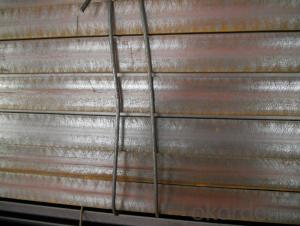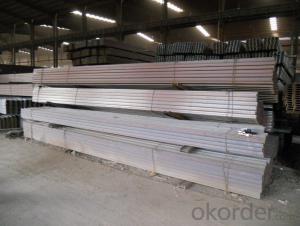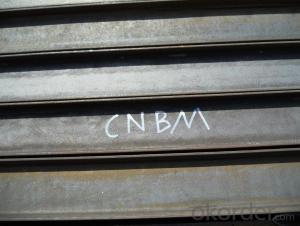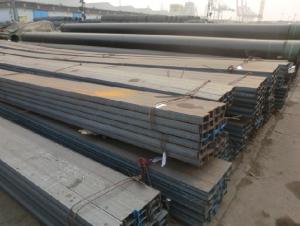Hot rolled stainless steel I-Beam for construction
- Loading Port:
- Tianjin
- Payment Terms:
- TT or LC
- Min Order Qty:
- 25 m.t.
- Supply Capability:
- 100000 m.t./month
OKorder Service Pledge
OKorder Financial Service
You Might Also Like
Hot rolled stainless steel I-Beam for constructionProduct Description:
OKorder is offering Hot rolled stainless steel I-Beam for construction at great prices with worldwide shipping. Our supplier is a world-class manufacturer of steel, with our products utilized the world over. OKorder annually supplies products to European, North American and Asian markets. We provide quotations within 24 hours of receiving an inquiry and guarantee competitive prices.
Product Applications:
Hot rolled stainless steel I-Beam are ideal for structural applications and are widely used in the construction of buildings and bridges, and the manufacturing, petrochemical, and transportation industries.
Product Advantages:
OKorder's Steel I-Beam for construction are durable, strong, and resist corrosion.
Main Product Features:
· Premium quality
· Prompt delivery & seaworthy packing (30 days after receiving deposit)
· Corrosion resistance
· Can be recycled and reused
· Mill test certification
· Professional Service
· Competitive pricing
Product Specifications:
Applications of IPEAA Beam
1. structure construction and electronic tower building construction
2. bridge, trestle, autos, brackets, machinery
3.It is widely used in various building structures and engineering structures such as roof beams, bridges, transmission towers, hoisting machinery and transport machinery, ships, industrial furnaces, reaction tower, container frame and warehouse etc.
Package & Delivery Terms of IPEAA Beam
1. Packing: it is nude packed in bundles by steel wire rod
2. Bundle weight: not more than 3.5MT for bulk vessel; less than 3 MT for container load
3. Marks:
Color marking: There will be color marking on both end of the bundle for the cargo delivered by bulk vessel. That makes it easily to distinguish at the destination port.
Tag mark: there will be tag mark tied up on the bundles. The information usually including supplier logo and name, product name, made in China, shipping marks and other information request by the customer.
If loading by container the marking is not needed, but we will prepare it as customer request.
4. All the IPEAA Beams will be delivered to the port of Tianjin within 45 days after receiving the Original L/C at sight or the advance payment by T/T.
5. Transportation: the goods are delivered by truck from mill to loading port, the maximum quantity can be loaded is around 40MTs by each truck. If the order quantity cannot reach the full truck loaded, the transportation cost per ton will be little higher than full load.
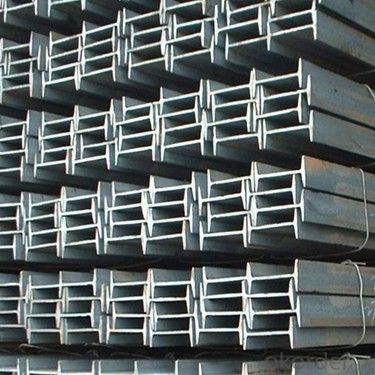
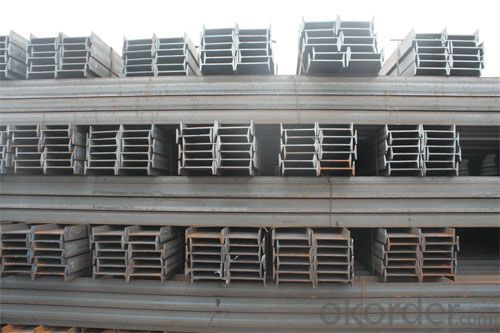
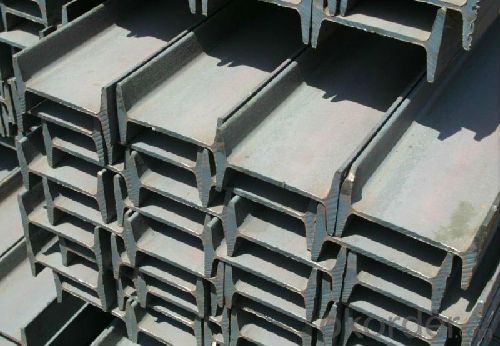
FAQ:
Q1: What makes stainless steel stainless?
A1: Stainless steel must contain at least 10.5 % chromium. It is this element that reacts with the oxygen in the air to form a complex chrome-oxide surface layer that is invisible but strong enough to prevent further oxygen from "staining" (rusting) the surface. Higher levels of chromium and the addition of other alloying elements such as nickel and molybdenum enhance this surface layer and improve the corrosion resistance of the stainless material.
Q2: Can stainless steel rust?
A2: Stainless does not "rust" as you think of regular steel rusting with a red oxide on the surface that flakes off. If you see red rust it is probably due to some iron particles that have contaminated the surface of the stainless steel and it is these iron particles that are rusting. Look at the source of the rusting and see if you can remove it from the surface.
- Q:How do you calculate the required number of steel I-beams for a project?
- To calculate the required number of steel I-beams for a project, you need to determine the total weight or load that the I-beams will need to support. From there, you can consult engineering tables or consult with a structural engineer to determine the appropriate beam size and spacing needed to safely support the load. Once you have the required beam size and spacing, you can then calculate the number of I-beams needed by dividing the total length of the project by the spacing between the beams.
- Q:Are there any alternatives to steel I-beams for structural support in construction?
- Yes, there are numerous options for structural support in construction instead of steel I-beams. One possibility is to utilize reinforced concrete beams, which involve embedding steel rebar within the concrete. This combination allows for both the compressive strength of concrete and the tensile strength of steel, resulting in highly durable beams capable of withstanding heavy loads. Another option is the use of laminated timber beams, also known as glulam beams. These beams are created by bonding multiple layers of timber together using adhesives. As a result, they are not only strong and lightweight but also aesthetically pleasing. Glulam beams offer a sustainable alternative to steel since they are made from renewable resources and have a lower carbon footprint. In addition, engineered wood products like laminated veneer lumber (LVL) and parallel strand lumber (PSL) can serve as alternatives to steel I-beams. LVL is manufactured by layering thin wood veneers and bonding them together, creating a robust and dimensionally stable beam. PSL, on the other hand, is produced by aligning and bonding wood strands, resulting in a beam with high strength and stiffness. Fiber-reinforced polymers (FRP) are also emerging as an alternative to steel I-beams. FRP composites consist of fibers embedded in a polymer matrix, such as carbon fiber reinforced polymer (CFRP) or glass fiber reinforced polymer (GFRP). These materials offer excellent strength-to-weight ratios, corrosion resistance, and durability. However, they are still undergoing research and development for widespread use in construction. In conclusion, despite the common utilization of steel I-beams for structural support in construction, there are several viable alternatives available, including reinforced concrete beams, laminated timber beams, engineered wood products, and fiber-reinforced polymers. The choice of an alternative will depend on various factors such as load requirements, design preferences, sustainability objectives, and cost considerations.
- Q:How do engineers determine the appropriate size and type of steel I-beam for a project?
- Engineers determine the appropriate size and type of steel I-beam for a project through a detailed analysis of various factors. Firstly, they consider the structural requirements of the project, which includes the load-bearing capacity, span length, and anticipated loads such as dead loads (permanent) and live loads (temporary). To determine the required size of the I-beam, engineers perform structural calculations and utilize engineering principles, such as bending moment, shear force, and deflection analysis. These calculations help engineers understand the forces and stresses acting on the beam, allowing them to select an appropriate size that can safely support the anticipated loads without failing. Furthermore, engineers consider the type of steel I-beam based on the specific project requirements. Different steel grades offer varying strength, ductility, and resistance to corrosion. Engineers assess the environmental conditions, exposure to moisture, and potential chemical influences to select a steel type that can withstand these factors and maintain its structural integrity over time. In addition to structural considerations, engineers also take into account cost-effectiveness and availability of the steel I-beams. They aim to find a balance between meeting the project requirements and minimizing unnecessary expenses. This involves considering the standard sizes and shapes available in the market, ensuring that the chosen I-beam can be easily sourced and integrated into the project without significant delays or additional costs. Overall, the determination of the appropriate size and type of steel I-beam for a project is a meticulous process that requires careful consideration of the structural requirements, load calculations, material properties, and economic factors. Engineers employ their expertise, knowledge of engineering principles, and relevant design codes and standards to ensure the safe and efficient use of steel I-beams in construction projects.
- Q:Are steel I-beams affected by temperature changes?
- Yes, steel I-beams are indeed affected by temperature changes. Like any other material, steel expands when it is heated and contracts when it is cooled. This thermal expansion and contraction can cause the steel I-beams to change shape, length, and size. As a result, temperature fluctuations can lead to stress and strain on the I-beams, potentially compromising their structural integrity. When exposed to high temperatures, the steel I-beams expand, which can put them under tension. On the other hand, when subjected to low temperatures, the I-beams contract, leading to compression. These changes in length and shape can induce bending, warping, or even buckling of the I-beams. It is crucial to account for temperature changes when designing and constructing structures that incorporate steel I-beams. Engineers must consider the coefficient of thermal expansion for steel and take appropriate measures to compensate for these effects. Additionally, proper insulation and ventilation systems can help to minimize temperature fluctuations and reduce the impact on the steel I-beams. Regular maintenance and inspections are also essential to ensure the structural integrity of steel I-beams. Temperature changes, along with other factors such as corrosion and fatigue, can gradually weaken the beams over time. Therefore, monitoring and addressing any signs of damage or deformation promptly is crucial to prevent potential failures or accidents.
- Q:How do steel I-beams perform in high humidity environments?
- Steel I-beams perform well in high humidity environments. Steel is highly resistant to moisture and does not easily corrode or degrade in humid conditions. It also maintains its structural integrity and strength, making it a suitable choice for construction in areas with high humidity. However, proper maintenance and occasional inspections are still recommended to prevent any potential issues related to humidity.
- Q:What are the common challenges in erecting steel I-beams on-site?
- Some common challenges in erecting steel I-beams on-site include the need for heavy machinery and equipment to lift and position the beams, ensuring the proper alignment and levelness of the beams, coordinating with other trades and contractors to ensure a smooth installation process, and addressing any unexpected site conditions or obstacles that may hinder the installation process. Additionally, safety considerations and adherence to building codes and regulations are important factors to consider during the installation of steel I-beams.
- Q:What are the factors to consider when calculating load capacity for steel I-beams?
- To determine the load capacity of steel I-beams, various factors must be taken into account. These factors encompass the material properties of the steel, the beam's dimensions and shape, the support conditions, and the applied loads. Firstly, the material properties of the steel, including its type and grade, dictate the beam's strength and stiffness. Different steel alloys possess distinct tensile and yield strengths, directly impacting the load capacity. Thus, a thorough understanding of the steel's properties is crucial for precise load capacity calculations. Secondly, the dimensions of the I-beam, such as its depth, width, and thickness, significantly influence its load-carrying capacity. Generally, a larger and thicker beam possesses a higher load capacity. Additionally, the beam's cross-sectional shape affects its moment of inertia and resistance against bending, necessitating consideration. Furthermore, the support conditions play a vital role in determining the beam's load capacity. The manner in which the I-beam is supported, whether it is simply supported, fixed at both ends, or continuous over multiple supports, greatly impacts its maximum bending moment and shear forces. Moreover, accurately determining the applied loads on the I-beam is essential. These loads consist of dead loads, live loads, and other dynamic loads. Dead loads refer to the weight of the structure itself and any permanent fixtures, while live loads encompass temporary or variable loads such as people, furniture, or equipment. The magnitude, distribution, and duration of these loads must be carefully considered for accurate load capacity calculations. Additionally, if the I-beam is expected to support sensitive equipment, deflection criteria should also be taken into consideration. Excessive deflection could lead to operational issues, making it crucial to account for acceptable deflection limits during load capacity calculations. To ensure accurate calculations and safe structural design, it is essential to consult relevant design codes and standards, such as the American Institute of Steel Construction (AISC) Manual. Considering these factors is of utmost importance when calculating the load capacity for steel I-beams.
- Q:Can steel I-beams be used in sports or recreational facility construction?
- Yes, steel I-beams can be used in sports or recreational facility construction. Steel I-beams are commonly used in construction due to their strength, durability, and versatility. They provide structural support and are often used to create large open spaces in sports or recreational facilities, such as stadiums, indoor arenas, or gymnasiums. Additionally, steel I-beams can be easily customized and adjusted to meet specific design requirements, making them suitable for various types of sports or recreational facilities.
- Q:How do steel I-beams perform in terms of thermal expansion and contraction?
- Steel I-beams perform relatively well in terms of thermal expansion and contraction. Due to the nature of steel, it has a low coefficient of thermal expansion, meaning it does not expand or contract significantly when exposed to temperature changes. This characteristic makes steel I-beams highly stable and reliable in various applications, particularly in construction and structural engineering. When exposed to heat, steel I-beams expand gradually, but the expansion is minimal compared to other materials. This property allows them to maintain their structural integrity even under extreme temperature fluctuations. Similarly, when the temperature decreases, steel I-beams contract slightly, but again, the effect is negligible. The low thermal expansion and contraction of steel I-beams contribute to their durability and ability to withstand different environmental conditions. This thermal stability ensures that the beams retain their shape and strength, minimizing the risk of structural failure or deformation. However, it is important to note that steel is not completely immune to thermal expansion and contraction. In cases of extreme temperature changes, such as in fire situations or rapid cooling, steel can experience more significant expansion or contraction. Therefore, proper design considerations and fire protection measures should be implemented to account for these potential thermal effects. Overall, steel I-beams demonstrate excellent performance in terms of thermal expansion and contraction, making them a preferred choice for structural applications where stability and reliability are essential.
- Q:Are steel I-beams resistant to pests or insects?
- Steel I-beams have a high level of resistance against pests and insects, unlike wood, which is susceptible to termite infestations and other insect-related harm. Pests do not find steel beams appealing as a food source or habitat, making them an excellent choice for construction in areas with a high presence of pests. The durability and non-porous nature of steel also prevent pests from causing damage by burrowing into the beams. In addition, steel I-beams are not prone to rot or decay, further reducing the risk of attracting insects. Consequently, steel I-beams are widely regarded as highly resistant to pests and insects, offering long-lasting structural support without the concern of pest-related damage.
1. Manufacturer Overview |
|
|---|---|
| Location | |
| Year Established | |
| Annual Output Value | |
| Main Markets | |
| Company Certifications | |
2. Manufacturer Certificates |
|
|---|---|
| a) Certification Name | |
| Range | |
| Reference | |
| Validity Period | |
3. Manufacturer Capability |
|
|---|---|
| a)Trade Capacity | |
| Nearest Port | |
| Export Percentage | |
| No.of Employees in Trade Department | |
| Language Spoken: | |
| b)Factory Information | |
| Factory Size: | |
| No. of Production Lines | |
| Contract Manufacturing | |
| Product Price Range | |
Send your message to us
Hot rolled stainless steel I-Beam for construction
- Loading Port:
- Tianjin
- Payment Terms:
- TT or LC
- Min Order Qty:
- 25 m.t.
- Supply Capability:
- 100000 m.t./month
OKorder Service Pledge
OKorder Financial Service
Similar products
New products
Hot products
Related keywords
